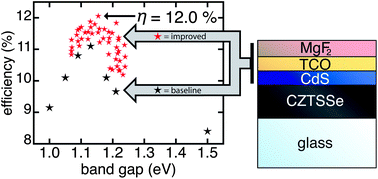
The researchers describe a new optical architecture for CZTSSe photovoltaic devices that improves the record power-conversion efficiency for this technology from 11.1 per cent to 12.0 per cent. CZTSSe absorbers are appealing for terawatt-scale thin-film solar deployment because they are composed of earth-abundant, non-toxic metals.
Using analytical modelling, verified by experiments, the team identified the optimal optical design for increasing the amount of light absorbed in the CZTSSe layer. The new design uses thinner CdS and transparent-conducting layers that lie atop the CZTSSe absorber.
The researchers also showed that that the approach typically used for solar-cell photon management – that is minimising the number of photons reflected from the solar cell surface – does not maximise current for this type of device.
Read the full details of this article in Energy & Environmental Science:
Optical designs that improve the efficiency of Cu2ZnSn(S,Se)4 solar cells
Mark T. Winkler, Wei Wang, Oki Gunawan, Harold J. Hovel, Teodor K. Todorov and David B. Mitzi
DOI: 10.1039/C3EE42541J










